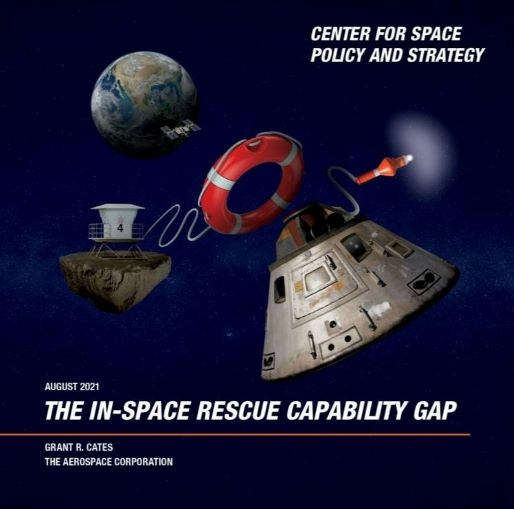Humanity needs a space-rescue capability, report stresses

With an increasing cadence, humans from multiple nations are rocketing into Earth orbit, and soon some will head outward to the moon. Given the boost in commercial and governmental flights, the chances of a stranded crew requiring an in-space rescue are on the rise.
But the United States government and commercial spaceflight providers have no plans in place to conduct a timely rescue of a crew from a distressed spacecraft in low Earth orbit, or anywhere else in space. Without orchestrated rescue planning, today's space travelers will journey at their own risk.
For example, this week's Inspiration4 mission is the world's first all-civilian trek into orbit. It will carry four private citizens to Earth orbit aboard a SpaceX Crew Dragon spacecraft for a three-day jaunt.
Then there's the dearMoon project, a lunar tourism mission and art project conceived and financed by Japanese billionaire Yusaku Maezawa. It will make use of a SpaceX Starship on a private spaceflight flying a circumlunar trajectory around the moon. This week-long journey of Maezawa and crewmates is expected to occur no earlier than 2023.
Related: Inspiration4: When to watch and what to know
Live updates: SpaceX's Inspiration4 private all-civilian orbital mission

Present posture
As private space tourism blossoms and other nations perfect their own human space travel adventures, it's time to revisit space rescue policies and put in place measures to address this topic, some experts say. They argue that the present posture — of not planning for in-space rescue and not having responsive in-space rescue capabilities — needs to be addressed before the need for a rescue materializes.
A report published last month called "The In-space Rescue Capability Gap" seeks to raise awareness of the need to revisit space rescue policies and put in place measures to address this issue.
Get the Space.com Newsletter
Breaking space news, the latest updates on rocket launches, skywatching events and more!
The author of the 21-page report, Grant Cates, is a senior project leader for The Aerospace Corporation's Space Architecture Department. Previously, he served as a NASA "flow director" for space shuttle Columbia, integrating, scheduling and conducting ground processing for the vehicle. He was the flow director for Columbia from 1995 through 2001, prior to the craft's tragic disintegration on Feb. 1, 2003 as it re-entered the atmosphere, killing all seven crew members.
Columbia broke apart because of damage suffered during launch, when dislodged insulation foam from the shuttle's external fuel tank hit the shuttle's wing. The Columbia Accident Investigation Board concluded that, if NASA had recognized the damage at the start of the mission, a rescue mission using the next space shuttle due for launch, Atlantis, would have been feasible, Cates told Space.com.
That rescue would have entailed maneuvering Atlantis next to Columbia and then transferring the crewmembers via individual spacewalks. "This rescue was considered challenging but feasible," the Columbia Accident Investigation Board wrote in volume one of its report.
Related: No launch day jitters for SpaceX's civilian Inspiration4 astronauts
Human nature
Fighting the fog of history is tough to do.
"It is human nature to be optimistic and have confidence in systems, especially when the last accident, Columbia, is farther and farther back in the past," Cates said. The on-orbit rescue piece of the puzzle is where more attention must be paid, he added.
"If something goes wrong on orbit, we haven't really fully thought through all the ways in which we might need to do a rescue, and how might we do that rescue," Cates said.
"A space rescue capability is likely to be highly synergistic with the long-sought-after capability of having responsive launch capability," Cates wrote in "The In-space Rescue Capability Gap."
Both of those goals are achievable with the right policy aims, he added.
"It should be the policy of the United States to develop and put in place rapid launch-on-need capability to support: timely rescue of astronauts in cis-lunar space; rapid reconstitution of nationally important space assets; and the ability to put in place new space capabilities in response to emerging threats in near real time," Cates wrote.
Imagine the public outcry, Cates added, that could arise if Inspiration4, dearMoon or a similar crewed mission were stuck in low Earth orbit or cislunar space by a disabled spacecraft. How long could a crew survive within their broken spaceship?
In his report, Cates noted that the plan for the Inspiration4 Crew Dragon spacecraft involved removing the International Space Station docking port and replacing it with a viewing window. "The removal of the docking port nullifies any potential for rescue," he wrote.
If a crewed cis-lunar mission encountered trouble near the moon, they could potentially hobble their way to the Gateway, a small moon-orbiting space station that NASA plans to build in the next few years, and wait to be rescued there.
"But in the near term, the only suggestion is to consider sending people beyond low Earth orbit with spaceships that have self-rescue capability," Cates said. Or we could potentially send multiple ships that travel together in a flotilla, like the ancient mariners did, he said.

Detrimental impact
"Regardless of whether it's a mission where NASA astronauts fly, private astronauts, or so-called space tourists are flying, if there's a mishap, it's going to have a near-term, detrimental impact on the industry," Cates said. There would be a stand-down until an accident investigation was completed, he said, and mitigations were put in place to prevent a similar calamity from happening in the future.
"Avoiding that type of thing in the first place, to me, seems to be the better course of action. That's what prompted the paper. Let's try to figure out in-space rescue before we actually need it," Cates said.
Cates points to historical analogs, such as ocean explorers who embarked upon epic journeys with multiple ships; successful submarine rescue operations; and the rich history of human spaceflight.
The paper offers a series of conclusions:
The United States has no present capability or policy for conducting in-space rescues. This situation exists today despite experts having studied space escape and rescue systems since 1959; despite NASA demonstrating a self-rescue capability during the aborted Apollo 13 mission to the moon in 1970; despite NASA putting in place rescue capabilities for the Skylab project carried out from 1973 to 1974; and despite the loss of space shuttle Columbia and her seven-person crew, a tragedy that could potentially have been avoided if a rescue capability had been available.
Rescue and return
The 1967 Outer Space Treaty alludes to the potential need to rescue astronauts in space. The next year, a second treaty came into force that is known as the Rescue Agreement of 1968. However, this latter treaty is primarily focused upon the rescue and return of astronauts who have made emergency landings somewhere on terra firma.
"What the treaty doesn't do," Cates said, "is that it does not require anybody to develop capabilities to do space rescue."
A key point that Cates underscores is having a launch-on-demand capability. And that capability is close at hand. "Essentially, somebody somewhere on this planet is launching something into orbit approximately every third day, on average. And that's going to increase," he said.
With more and more nations flying people into space, the need to have rescue capabilities is going to become more obvious, Cates said. Second, the ability to put space-rescue steps in place is likely to become easier. "That's one way to close the current gap," he said.
Yet another area that needs attention is taking a look at international docking system standards. Are the docking mechanisms used by various nations fully compliant, allowing them to link up not only with the International Space Station but also with each other? Cates said there seems to be some debate about this compatibility issue.
Related: Building the International Space Station (photos)
So what now?
One option is not having a centralized government space rescue capacity. Since commercial crewed launches from the United States are licensed by the Federal Aviation Administration (FAA), perhaps that agency could invoke rules and regulations to make a space rescue requirement compulsory.
Maybe an international consortium approach should be considered, having all spacefaring nations pool their collective resources to develop and maintain rescue capabilities.
What about extending the duties of the U.S. Space Force to include space rescue responsibilities? Suggestions have also been made that the United States could create a "Space Guard" analogous to the Coast Guard to implement in-space rescue.
The report flags the fact that the United States, as the dominant spacefaring nation, has the wherewithal to establish space rescue capabilities "and to do so with a sense of urgency."
Those skills will undoubtedly be developed in the future. "The only question is if they will be developed before or after the next crisis that requires that capability," the report concludes.
Leonard David is author of the book "Moon Rush: The New Space Race," published by National Geographic in May 2019. A longtime writer for Space.com, David has been reporting on the space industry for more than five decades. Follow us on Twitter @Spacedotcom or Facebook.
Join our Space Forums to keep talking space on the latest missions, night sky and more! And if you have a news tip, correction or comment, let us know at: community@space.com.

Leonard David is an award-winning space journalist who has been reporting on space activities for more than 50 years. Currently writing as Space.com's Space Insider Columnist among his other projects, Leonard has authored numerous books on space exploration, Mars missions and more, with his latest being "Moon Rush: The New Space Race" published in 2019 by National Geographic. He also wrote "Mars: Our Future on the Red Planet" released in 2016 by National Geographic. Leonard has served as a correspondent for SpaceNews, Scientific American and Aerospace America for the AIAA. He has received many awards, including the first Ordway Award for Sustained Excellence in Spaceflight History in 2015 at the AAS Wernher von Braun Memorial Symposium. You can find out Leonard's latest project at his website and on Twitter.









